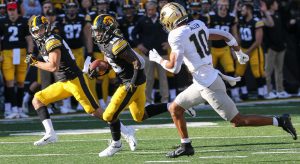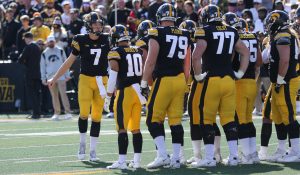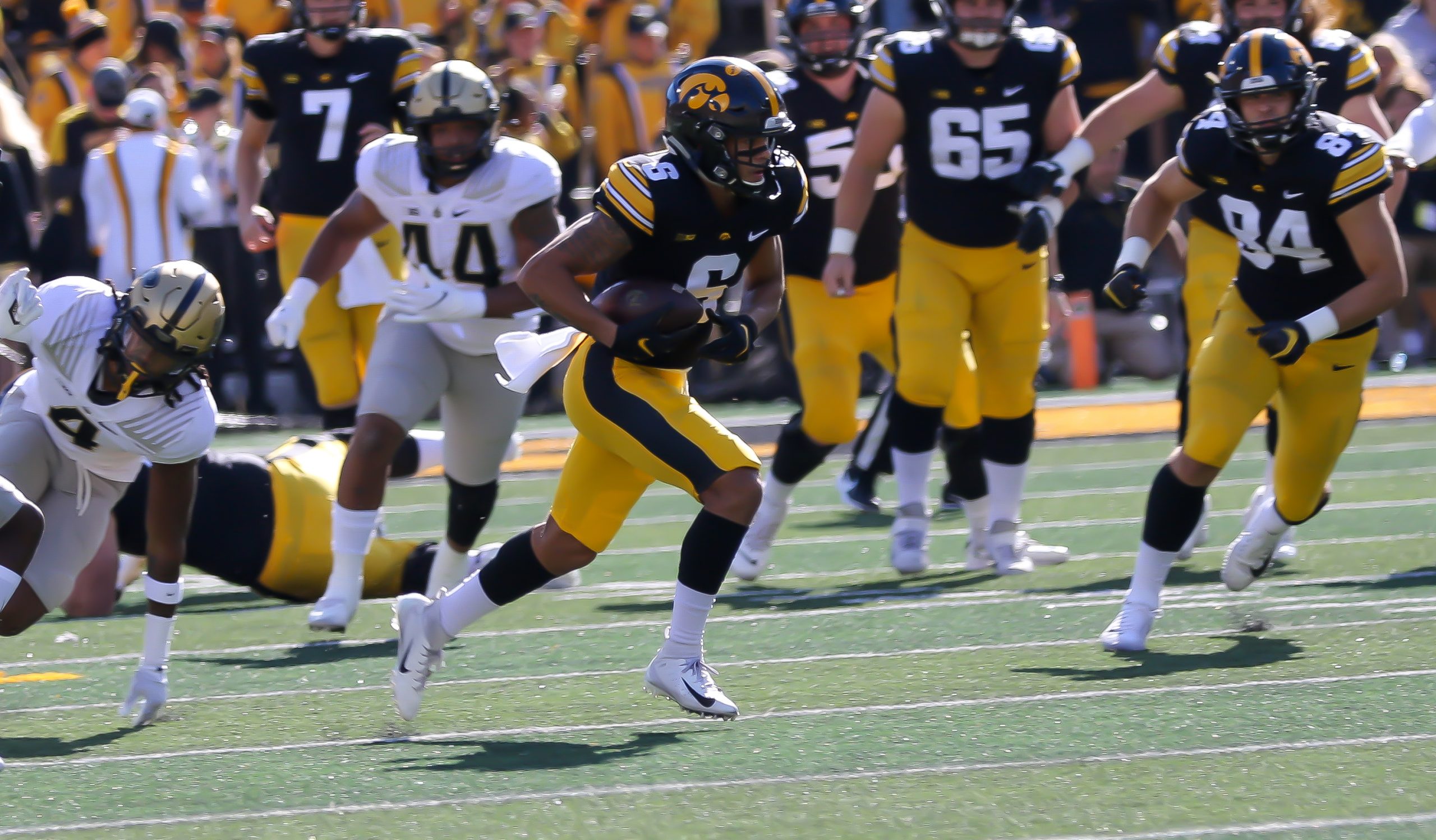Iowa offense has to step up before it’s too late
By Pat Harty
IOWA CITY, Iowa – A football team can go a long way by excelling on defense, and on special teams, as shown by the 2021 Iowa Hawkeyes.
But that was before Purdue came to Kinnick Stadium on Saturday and did what it usually does against Iowa since Jeff Brohm became the Purdue head coach in 2017, which is win.
The Boilermakers handed Iowa its first loss of the season, and its first loss in nearly a year, winning 24-7 on a somber homecoming.
Purdue is now 4-1 against Iowa under Brohm, and the biggest takeaway from Saturday’s game is that Iowa’s inability to do its part on offense finally proved costly.
It’s easier to joke about Iowa being boring, predictable and methodical on offense during times of success, because it sort of reinforces Iowa’s image of winning games the old-fashioned way, with toughness, grit, and sound fundamentals, and with more force than flash.
But the game has also changed a lot since 1981 when Iowa rode its defense and special teams to a Big Ten title under Hayden Fry.
Iowa climbed all the way to No. 2 in the Associated Press poll despite its offensive shortcomings.
Getting there is one thing. But staying there is another.
A top-notch defense can usually keep a team in a game, and might even win a few games, but at some point, the offense has to deliver.
At some point, the offense has to accept the burden of carrying a team to victory.
Iowa needed its offense to step up on Saturday to help a usually stout Iowa defense that was struggling to get off the field.
But instead, the offense mostly self-destructed as junior quarterback Spencer Petras threw four interceptions after having thrown just two in the first six games.
The play calling also left something to be desired, mostly because Iowa offensive coordinator Brian Ferentz seemed to lose faith in his running game, even though Tyler Goodson averaged 5.7 yards per carry against Purdue, gaining 68 yards on 12 carries.
Brian Ferentz called back-to-back quarterback sneaks on third and fourth down in the fourth quarter against Purdue, and both plays failed to get a first down.
Of course, it’s easy to judge using hindsight, and it’s true that Iowa has had success with quarterback sneaks.
But to call two quarterback sneaks in a row against a goal-line defense when you have a first-team All-Big Ten running back in Goodson, a fifth-year senior backup running back in Ivory Kelly-Martin, and a 246-pound fullback in Monte Pottebaum seems a little odd and misguided.
Goodson deserves to get more than just a dozen carries, especially when he’s averaging nearly six yards per attempt as was the case against Purdue.
He might lose yards on a few plays while dancing, side-stepping and spinning in search of a hole.
But Goodson is also capable of ripping off a big run at any time if he can just get in space, and when given enough opportunities.
Iowa’s running game is way too much feast and famine right now as long gains often get neutralized by runs for minus yards.
Junior center Tyler Linderbaum has been sensational this season, and he played well again on Saturday. But, obviously, he can’t do it by himself. The other starters on the offensive line have to perform better.
Kirk Ferentz was asked after the Purdue loss about the running game’s lack of consistency, but he apparently saw it differently.
“I’m not sure I see that totally,” Kirk Ferentz said. “I haven’t seen the film from today. But we had some pretty clean runs on them, six, eight, 10-yard plays.
“I feel like we had some really good, clean runs the last two weeks and showed improvement,”
Iowa did have some nice runs against Purdue, and against Penn State the week before.
But Iowa’s combined rushing totals for those two games was 75 carries for 186 net rushing yards. That averages out to just 2.48 yards per carry.
Sacks certainly factor into those numbers, but not enough to excuse the running game.
It would be easy to get carried away with the gloom and doom after such a disappointing loss, but Iowa still is 6-1 heading into a bye week.
“For our football team, it’s the first time we’ve had to deal with a loss in a while,” Kirk Ferentz said in his post-game press conference. “We’ll get a lesson in that.
“The biggest thing right now is we have to move forward. That’s what I shared with the team a few minutes ago.”
Ferentz is right about moving forward because the Big Ten West Division title still is within reach and Iowa has two weeks to get its injured players healthy.
As deflating as Saturday’s loss was from an emotional standpoint, it’s still just one loss.
But on the other hand, the offense has to improve in a hurry, or one loss could turn into two or three losses.
Iowa entered the Purdue game ranked last in the Big Ten in total offense (317.5), 12th in rushing offense (123.3) and 10th in pass efficiency offense.
Those numbers were easy to overlook until they finally cost Iowa.
The fact that Brian Ferentz basically abandoned the running game against Purdue in the second half was not a good sign, especially since the passing game also was struggling.

This Iowa team, and most of the Iowa teams under Kirk Ferentz, aren’t built to win without at least some help from the running game.
Goodson had some nice runs against Purdue, runs in which he got in space and did some damage.
He just didn’t have enough opportunities to get into a rhythm with just 12 carries.
Freshman receiver Keagan Johnson gained 38 yards on the first play from scrimmage on a short pass in which he made several defenders miss.
But he only had one catch for the rest of the game.
Johnson finished with 50 receiving yards, with 31 of his yards coming after the catch. He also entered the Purdue game with 137 receiving yards on just four catches, which is an average of 34.3 yards per catch.
In other words, Johnson has the ability to make big plays. But it’s hard to make big plays without getting the football on a somewhat regular basis.

And speaking of not getting the football, the lack of production from junior receiver Tyrone Tracy Jr. has been an ongoing problem this season, and it’s baffling.
The same receiver who had 36 catches for 589 yards during the 2019 season, highlighted by a 130-yard performance on six catches at Wisconsin, entered Saturday’s game with just 12 catches for 83 yards and one touchdown this season.
Tracy was a non-factor in the passing game again on Saturday.
He ran an end sweep in the first quarter that gained one yard, but that was about it for Tracy.
There were plays in which he looked open, but his connection with Petras is severely lacking right now.
Tracy has dropped some passes this season, but he isn’t the only one guilty of that. And he hasn’t dropped enough to be reduced to a non-factor in the passing game.
Petras is most comfortable throwing to tight end Sam LaPorta, who was targeted nine times against Purdue and finished with five catches for 61 yards.
But it takes more than a tight end to carry a passing attack, and right now, Iowa’s receivers aren’t holding up their end of the deal.
But is it their fault?
Or is the fault of Brian Ferentz and the play calling?
Purdue receiver David Bell certainly has a target on his back, and containing him is a priority for any defense. And yet, he still had 11 catches for a Kinnick Stadium record 240 yards against Iowa, partly because he was targeted 12 times.
Bell is clearly at a different level than any of Iowa’s receivers. But he also benefits from consistently having opportunities to make catches.
With Iowa, on the other hand, it’s hard knowing who besides LaPorta will get touches.
The Iowa defense certainly didn’t live up to its high standards against Purdue.
But a team also can’t be carried by its defense and special teams for an entire season.
At some point, that burden shifts to the offense as was the case on Saturday, but the offense failed to deliver.
Iowa had won 12 straight games with Petras starting at quarterback, so any talk of him being benched for an unproven backup after just loss would seem to be an overreaction.
But Petras has to play better, and Brian Ferentz, who is Kirk Ferentz’s son, has to make it easier for him to play better.
Tracy and Keagan Johnson are two of Iowa’s most explosive players on offense, and yet, they rarely get any touches.
That has to change in a hurry.
Iowa has to figure a better way to stretch defenses or opponents will continue to load the box to stuff the run.
Iowa’s next game is against Wisconsin on Oct. 30 in Madison, Wisconsin.
And though the Badgers are struggling at 3-3, it’s to no fault of their defense.
It’s hard to see Iowa beating Wisconsin if it performs on offense like it did against Purdue.
Brian Ferentz has two weeks to come up with ways to get his playmakers more involved, and to make the running game more consistent and reliable, because again, it takes more than defense and special teams to be elite.
The pressure is on the Iowa offense to rise to the occasion and do its part before it’s too late.



